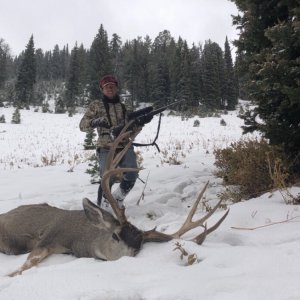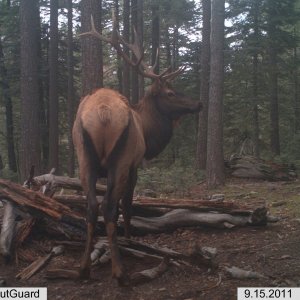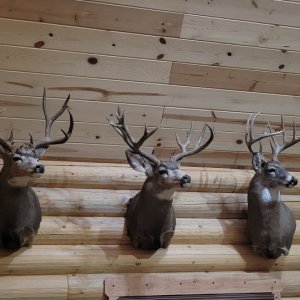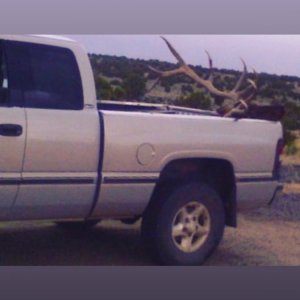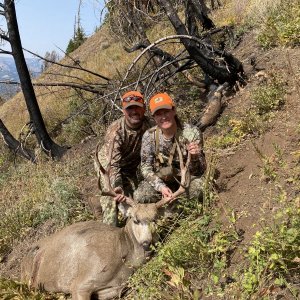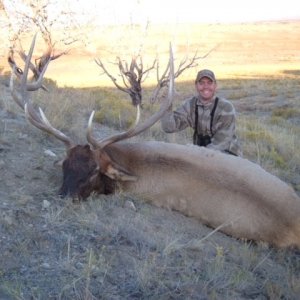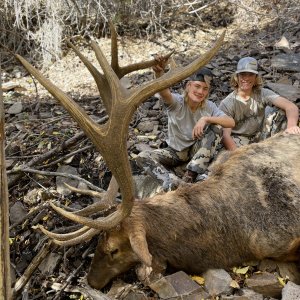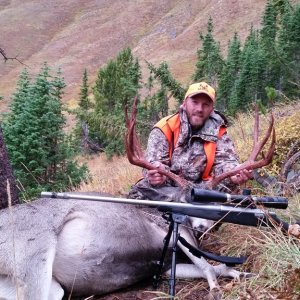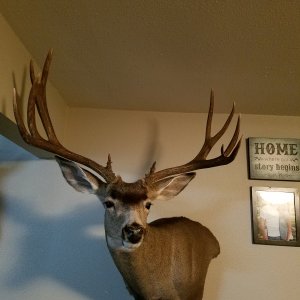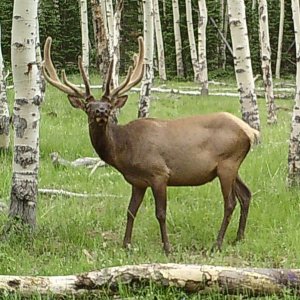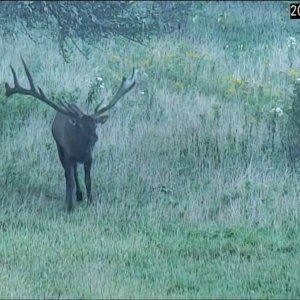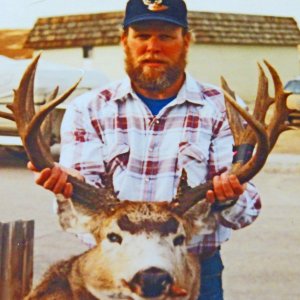ICMDEER
Very Active Member
- Messages
- 2,994
Now - if we could just find a way to get it out of our wildlife populations..........
Long-term research shows domestic cattle resist oral exposure to Chronic Wasting Disease
Cattle fed extremely high oral doses of Chronic Wasting Disease-infected brain material or kept in heavily prion-contaminated facilities for 10 years showed no neurological signs of the disease.
The University of Wyoming?s Wyoming State Veterinary Laboratory (WSVL), Colorado Division of Parks and Wildlife and the Wyoming Game and Fish Department (WGFD) collaborated in the $1.5 million study. Results will be published in the July issue of the Journal of Wildlife Diseases. Details of the study are available at bit.ly/10yearCWD.
As part of the experiment, 41 calves were randomly distributed to WGFD pens in Sybille Canyon in Wyoming, Colorado Division of Wildlife pens in Fort Collins, the WSVL and 18 to the National Animal Disease Center in Ames, Iowa.
?It was an elegant experiment in many ways,? said Hank Edwards, WGFD wildlife disease specialist. ?You were taking cattle and housing them with heavily infected CWD elk and facilities. If CWD was going to jump the species barrier, it was likely you would see something in these cattle that had laid out in the pens for 10 years. That's a big deal.?
The late Beth Williams, a veterinary sciences professor at UW, initiated the study. Authors of the article continued the research after she and husband, Tom Thorne, were killed in a motor vehicle crash in December 2004. Thorne had served as acting director of the WGFD and had also conducted CWD research.
Authors of the article are Donal O?Toole, a professor in the UW Department of Veterinary Sciences, which operates the WSVL; Michael Miller, a veterinary epidemiologist with the Colorado Division of Parks and Wildlife; Terry Kreeger, a wildlife veterinarian with the WGFD; and Jean Jewell, a molecular biologist with the WSVL. Williams is listed as lead author.
CWD is a contagious neurological disease affecting cervids: mule deer, white-tailed deer, elk and moose. An abnormal form of cellular protein called a prion in the central nervous system infects an animal by converting normal cellular protein into the abnormal form. Brains show a spongy degeneration, with animals displaying abnormal behavior, loss of bodily functions and emaciation. The disease is fatal. It is among a group of diseases called transmissible spongiform encephalopathies. (TSEs). TSE in cattle is also known as mad cow disease.
The long timespan of the research is important, since CWD is a slow disease, said Mary Wood, state WGFD veterinarian.
Even in deer or elk, animals can take years to succumb to the disease, she said. If the disease were to move into a different species, such as cattle, the timeline could be even longer for infection to occur.
?Many people are used to diseases moving quickly, but CWD doesn't do that,? Wood said. ?Nothing happens quickly ? which is what makes this disease so insidious. It creeps up on you. It's subtle. By the time you realize there is a problem, the disease is so widespread and established it's difficult to try to address.?
Some cattle can get a form of TSE when CWD material is injected directly into their brains, particularly when it is of white-tail or mule deer origin, said O?Toole.
He said a more important question is one Williams and collaborators asked, since it involved a more natural challenge.
?What happens in cattle when you use a more real-life scenario involving oral exposure?? O?Toole said. ?Plus, we used high oral doses and heavily contaminated environments. Cattle coming out of endemic CWD areas and slaughtered for human consumption are likely to pose no risk to people based on the 10-year study and several earlier surveillance studies.?
That should be good news to livestock producers, said Wood.
?Managing disease in animals can be incredibly challenging,? she said. ?It is even more challenging when the disease infects wildlife and is shared between wildlife and livestock.?
Wyoming cattle share the range with CWD-infected cervids, with CWD seen across almost the entire state of Wyoming, said Edwards.
?This research indicated CWD doesn't easily transmit to cattle. Cattle do not get the disease due to a big species barrier, which helps restrict the disease to cervids,? he said.
Some Wyoming deer populations have 20-30 percent infection rates.
?We have few tools in the toolbox to manage the disease,? Edwards said. ?We are trying different management efforts to hold the prevalence level, if not reduce the spread. That's the big thing coming up next for CWD. How do we control it in our wildlife populations??
Long-term research shows domestic cattle resist oral exposure to Chronic Wasting Disease
Cattle fed extremely high oral doses of Chronic Wasting Disease-infected brain material or kept in heavily prion-contaminated facilities for 10 years showed no neurological signs of the disease.
The University of Wyoming?s Wyoming State Veterinary Laboratory (WSVL), Colorado Division of Parks and Wildlife and the Wyoming Game and Fish Department (WGFD) collaborated in the $1.5 million study. Results will be published in the July issue of the Journal of Wildlife Diseases. Details of the study are available at bit.ly/10yearCWD.
As part of the experiment, 41 calves were randomly distributed to WGFD pens in Sybille Canyon in Wyoming, Colorado Division of Wildlife pens in Fort Collins, the WSVL and 18 to the National Animal Disease Center in Ames, Iowa.
?It was an elegant experiment in many ways,? said Hank Edwards, WGFD wildlife disease specialist. ?You were taking cattle and housing them with heavily infected CWD elk and facilities. If CWD was going to jump the species barrier, it was likely you would see something in these cattle that had laid out in the pens for 10 years. That's a big deal.?
The late Beth Williams, a veterinary sciences professor at UW, initiated the study. Authors of the article continued the research after she and husband, Tom Thorne, were killed in a motor vehicle crash in December 2004. Thorne had served as acting director of the WGFD and had also conducted CWD research.
Authors of the article are Donal O?Toole, a professor in the UW Department of Veterinary Sciences, which operates the WSVL; Michael Miller, a veterinary epidemiologist with the Colorado Division of Parks and Wildlife; Terry Kreeger, a wildlife veterinarian with the WGFD; and Jean Jewell, a molecular biologist with the WSVL. Williams is listed as lead author.
CWD is a contagious neurological disease affecting cervids: mule deer, white-tailed deer, elk and moose. An abnormal form of cellular protein called a prion in the central nervous system infects an animal by converting normal cellular protein into the abnormal form. Brains show a spongy degeneration, with animals displaying abnormal behavior, loss of bodily functions and emaciation. The disease is fatal. It is among a group of diseases called transmissible spongiform encephalopathies. (TSEs). TSE in cattle is also known as mad cow disease.
The long timespan of the research is important, since CWD is a slow disease, said Mary Wood, state WGFD veterinarian.
Even in deer or elk, animals can take years to succumb to the disease, she said. If the disease were to move into a different species, such as cattle, the timeline could be even longer for infection to occur.
?Many people are used to diseases moving quickly, but CWD doesn't do that,? Wood said. ?Nothing happens quickly ? which is what makes this disease so insidious. It creeps up on you. It's subtle. By the time you realize there is a problem, the disease is so widespread and established it's difficult to try to address.?
Some cattle can get a form of TSE when CWD material is injected directly into their brains, particularly when it is of white-tail or mule deer origin, said O?Toole.
He said a more important question is one Williams and collaborators asked, since it involved a more natural challenge.
?What happens in cattle when you use a more real-life scenario involving oral exposure?? O?Toole said. ?Plus, we used high oral doses and heavily contaminated environments. Cattle coming out of endemic CWD areas and slaughtered for human consumption are likely to pose no risk to people based on the 10-year study and several earlier surveillance studies.?
That should be good news to livestock producers, said Wood.
?Managing disease in animals can be incredibly challenging,? she said. ?It is even more challenging when the disease infects wildlife and is shared between wildlife and livestock.?
Wyoming cattle share the range with CWD-infected cervids, with CWD seen across almost the entire state of Wyoming, said Edwards.
?This research indicated CWD doesn't easily transmit to cattle. Cattle do not get the disease due to a big species barrier, which helps restrict the disease to cervids,? he said.
Some Wyoming deer populations have 20-30 percent infection rates.
?We have few tools in the toolbox to manage the disease,? Edwards said. ?We are trying different management efforts to hold the prevalence level, if not reduce the spread. That's the big thing coming up next for CWD. How do we control it in our wildlife populations??

